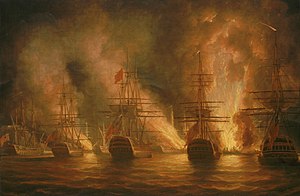This article needs additional citations for verification. (February 2010) |
| Capture of Trinidad | |||||||||
|---|---|---|---|---|---|---|---|---|---|
| Part of the French Revolutionary Wars | |||||||||
 "The Capture of Trinidad, 17 February 1797" by Nicholas Pocock | |||||||||
| |||||||||
| Belligerents | |||||||||
|
|
| ||||||||
| Commanders and leaders | |||||||||
|
|
| ||||||||
| Strength | |||||||||
|
10,000 soldiers and marines[1] 18 ships: 9 ships of line, 3 frigates, 3 corvettes, 3 sloops[2] |
2,100 soldiers, seamen and marines (including ~700 sick)[1] 4 ships of line 1 frigate[2] | ||||||||
| Casualties and losses | |||||||||
| 1 killed[3] |
2,100 captured (~700 sick)[3] 4 ships of the line scuttled 1 ship of the line captured[4] | ||||||||
On 18 February 1797, a fleet of 18 British warships under the command of Sir Ralph Abercromby invaded and took the Island of Trinidad. Within a few days the last Spanish Governor, Don José María Chacón surrendered the island to Abercromby.
As a result of the signing of the second Treaty of San Ildefonso in 1796 by the governments of Spain and France, by virtue of which both nations became allies, Spain automatically turned into an enemy of Great Britain. In retaliation, this latter country sent a fleet to the Caribbean with the intention of invading the islands of Trinidad and Puerto Rico, obtaining the surrender of the first, but being repelled in the second.
- ^ a b Joseph, Edward Lanzer (1970). History of Trinidad. Routledge. p. 190. ISBN 978-0-7146-1939-2.
- ^ a b Laborda, Antonio: La ocupación de la isla de Trinidad por los británicos en 1797, Revista de Historia Naval (in Spanish)
- ^ a b Southey, Thomas (1827). Chronological history of the West Indies. Vol. 3. London: Longman, Rees, Orme, Brown, and Green. p. 137.
- ^ Joseph, Edward Lanzer (1970). History of Trinidad. Routledge. p. 192. ISBN 978-0-7146-1939-2.